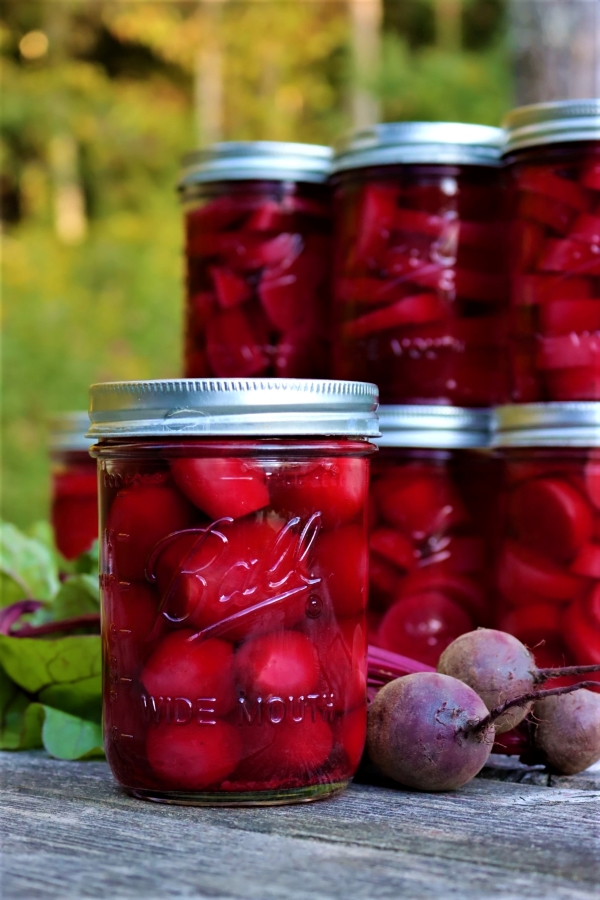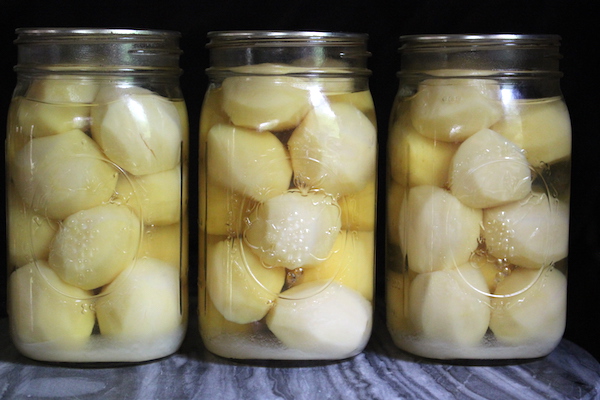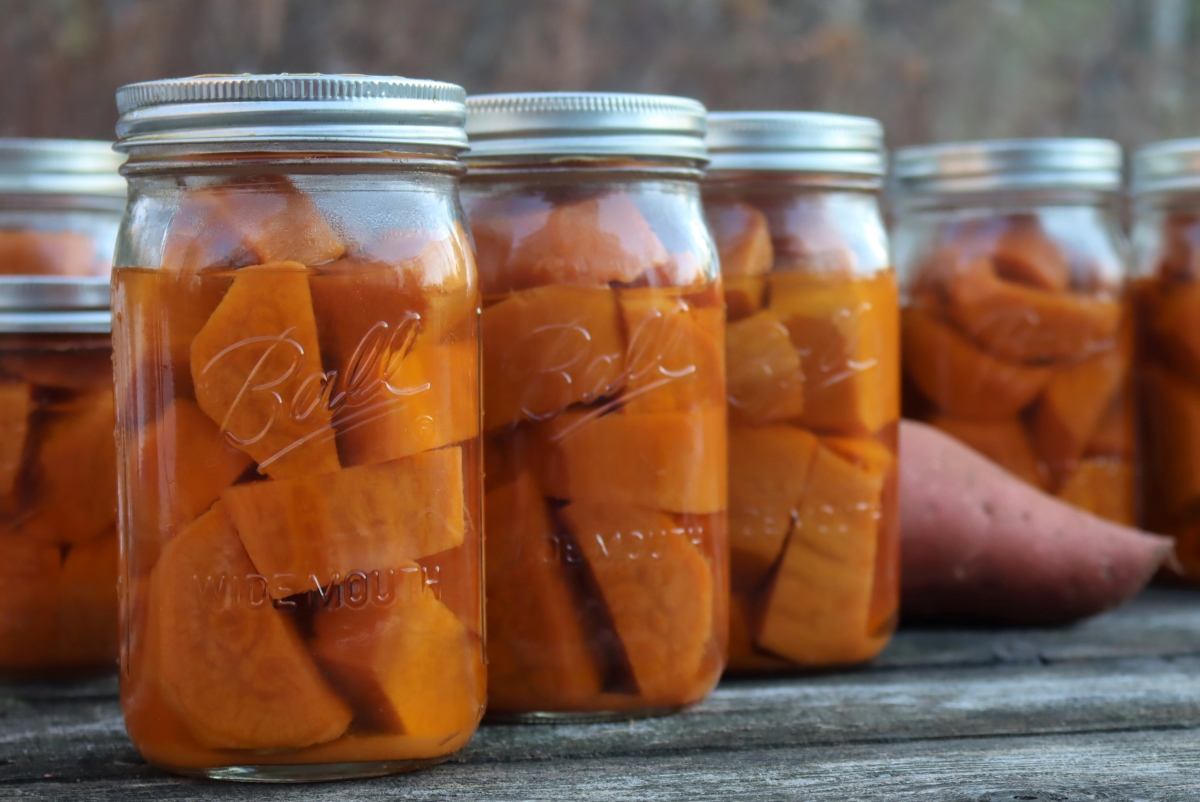This post may contain affiliate links. Please see our disclosure policy.
Root vegetable canning recipes allow you to put away your gardens roots right on your pantry shelf. I’ve got you covered for all the classics, from potatoes and carrots, onions and garlic, all the way to more obscure options.

Historically, roots were stored in a root cellar, but that’s often a bit tricky to recreate in a modern home. If you happen to have a good bit of land, you can use these free root cellar plans to create a root cellar, or you can convert part of your basement using these instructions for root cellaring foods without a root cellar. But for most people, root cellaring just isn’t all that practical.
That’s where canning root vegetables comes in.
It’ll still allow you to keep all these tasty, nutrient dense crops at home, and they’ll be at in easy reach right on your pantry shelf. While carrots take up a lot of refrigerator space, home canned carrots are just as good in all manner of recipes and they can be stored at room temperature.
Other root crops do wonderfully too, like potatoes, beets and more. Don’t let that bumper crop go to waste, can it instead!

Is Canning Root Vegetables Safe?
Most root vegetables are safe for pressure canning, but they are not approved for water bath canning. If all you have is a water bath canner, then you’ll still be able to make root vegetable pickles. Believe it or not, pickled beets and pickled carrots are truly amazing, and maybe even better than cucumber pickles.
If you’re new to pressure canning, please read my beginner’s guide to pressure canning before you get started. If you’re looking for a beginner friendly pressure canner, there’s nothing so easy to use as the Presto Electric Pressure Canner. (You can read my instructions on how to use an electric pressure canner, as well as my full presto electric pressure canner review. Be aware that you cannot use an instant pot for pressure canning, it doesn’t work the same way.)
If you plan to do a lot of canning, there’s nothing more long lasting and dependable than an All-American Pressure Canner. I have three of their canners, and they’re built to last generations.
For canning pickled root vegetables, you can use a water bath canner, provided you use a tested recipe that includes at least 50% vinegar in the brine. Here’s my beginner’s guide to water bath canning to get you started.

How to Can Root Vegetables
Generally, canning plain root vegetables involves first washing them, then peeling them. The peeling step is important for a couple of reasons.
First, the peels get bitter and stringy in the canner.
Second, the peels will separate from the veggies in many cases, especially with potatoes, and they’ll float up to the top of the jar…which isn’t fun for cooking later.
Third, and most importantly, the peels have the highest chance of carring botulism spores because of their ground contact. That’s why all canning recipes for root vegetables have you peel them first. Beyond the quality issues listed above, it’s actually a safety issue. Please make sure you peel your root vegetables before canning.

Once peeled, they’re chopped into manageable pieces, and in many cases smaller root vegetables under 2” in diameter can be left whole. Baby beets and new potatoes are good candidtaes for canning whole.
Next, you have a choice of raw pack or hot pack. Generally, hot pack results in better quality, but it’s a bit more work.
For hot pack, you place the veggies in boiling water for 5 minutes to heat them through, then pack hot into jars before topping with boiling water.
For raw pack, you simply pack the raw veggies into jars and then top with boiling water.
The jars are then processed in a pressure canner, and the total times depend on the vegetables in question.
White potatoes, for example, are processed for 35 minutes for pints and 40 minutes for quarts. Sweet potatoes, on the other hand, take a lot longer, and process for 65 minutes for pints and 90 minutes for quarts. Please be sure to refer to a tested recipe for the root vegetables in question.
With pressure canning, the processing times stay the same at higher altitude, but the pressures change. Here are the altitude adjustments for pressure canning:
For dial gauge pressure canners:
- 0 to 2,000 feet in elevation – 11 lbs pressure
- 2,001 to 4,000 feet in elevation – 12 lbs pressure
- 4,001 to 6,000 feet in elevation – 13 lbs pressure
- 6,001 to 8,000 feet in elevation – 14 lbs pressure
For weighted gauge pressure canners:
- 0 to 1,000 feet in elevation – 10 lbs pressure
- Above 1,000 feet – 15 lbs pressure

Canning Pickled Root Vegetables
The exception to the pressure canning rule is if you’re pickling root vegetables. In that case, the acidity of the pickling brine makes them safe for water bath canning. Be sure to use a tested recipe that includes a brine that’s at least 50% vinegar (at 5% acidity).
Again, canning times vary by vegetable, but in most cases the canning times are as follows:
- For 0 to 1,000 feet in elevation, process for 15 minutes
- For 1,000 to 6,000 feet in elevation, process for 20 minutes
- Above 6,000 feet in elevation, process jars for 25 minutes
Make sure you check with the specific tested pickling recipe in question, as this can vary a bit.

Root Vegetable Canning Recipes
Now that I’ve covered the basics, here are root vegetable canning recipes from A to Z. Each heading covers a different type of root, from the most common all the way out to more obscure and hard to find options. If I’ve missed your favorite roots, let me know in the comments and I’ll see what I can find for you.
Beets
I’ll be honest here, I do have a favorite canned root vegetable, and it’s beets. They’re absolutely perfect canned plain or pickled, though I prefer plain for their versatility.
A can of beets, drained and then topped with a bit of feta or goat cheese and a splash of balsamic is my idea of the perfect lunch. Pickled beets are great too, and many people prefer those to plain. They’re great alongside a heatry breakfast of lunch, and I love them next to hash browns.

Celeriac
At this point, there’s not a tested method for canning plain celeriac. Likely it wouldn’t be all that different than parsnips or turnips, but no one’s tested it to be sure (yet).
For now, try this pickling recipe.
Carrots
Incredibly versatile (and delicious) when canned plain, carrots are a staple of my weeknight dinner pantry. They can be put up in water, seasoned, or canned in broth for more flavor.
Pickled carrots have a nice sweetness, and they take on the seasonings from the pickle brine nicely.

Daikon
Though Diakon is technically just a radish, it’s common (and popular) enough to warrant it’s own category.
There’s not currently a tested recipe for canning plain radishes or daikon, but they make wonderful pickles.
Garlic
Sadly, there’s not a tested recipe for canning plain garlic. It loses its flavor in the pressure canner, so it’s more or less pointless.
Believe it or not, those jars of minced garlic you buy canned in the grocery store have enough citric acid added that they’re technically pickled so they can be water bath canned. Citric acid is pretty neutral in flavor, so you hardly notice.
There are plenty of tested vinegar pickled garlic recipes, and pickled garlic works wonderfully in recipes in place of garlic (or eaten out of the jar for true garlic lovers). You can also pickle garlic scapes, which are the green part of hardneck garlic that’s harvested in the summer.
And believe it or not, there’s even a tested recipe for savory roasted garlic jelly that’s great on charcuterie plates.

Ginger (& Turmeric)
At this point, there are no pressure canning recipes for either ginger or turmeric, largely because they lose their flavor when canned at such high temperatures. If you want them plain, freezing and dehydrating is a better option.
Pickled ginger and pickled turmeric are wonderful though, and can be used in place of the fresh version in many recipes. Generally, young fresh ginger (or turmeric) is pickled before it cures, so it’s really only something you’d make at home if you’re growing ginger or growing turmeric. Occasionally you can find it fresh at farmer’s markets or a well stocked organic grocery too.

Horseradish
At this point, there are no canning instructions for prepared horseradish, which is a shame. None the less, you can make prepared horseradish and store it in your refrigerator for months at a time.
The thing is, horseradish is only pungent fresh, and no matter what it will lose flavor after about 2 months in storage. That’s probably why there are no tested recipes for canning horseradish, pickled or plain.
Leeks
While leeks are often canned in soup canning recipes, they’re not tested specifically for canning on their own largely because they tend to turn to mush in a jar. In terms of canning safety, they can be used in place of regular onions in pressure canning recipes, but it’s really not worth it to can them on their own.
There are, however, a few pickled leek canning recipes to add to the soup canning recipes.
- Canning Potato Leek Soup
- Pickled Ramps (works with plain leeks or wild ramps)

Onions
Believe it or not, there is in fact a specific canning recipe for plain onions, and they work out wonderfully. You can open the whole jar and add it to soups or stews, along with the wonderful onion broth it creates in the jar.
Onions can also be canned as french onion soup, and they make amazing pickles.
- Canning Onions
- Canning French Onion Soup (recipe coming soon)
- Canning Pickled Onions

Parsnips
I absolutely love parsnips, and they can do wonderfully, in my opinion.
There are some people that say parsnips aren’t great canned, but I think maybe those people don’t like parsnips all that much fresh either. They taste pretty much the same when canned, and they’re conveniently stored on the pantry shelf.

Potatoes
While you might assume potatoes would get soggy during canning, they actually do really well. You can drain the jars and mash the potatoes, or simply heat and eat as they are.
If well drained, you can even use home canned potatoes for making home fried potatoes and they brown up nicely.
- Canning Potatoes
- Canning Sausage Potato and Kale Soup (Copycat Zuppa Toscana)
- Canning Beef Stew (with plenty of potatoes)

Radish
There are no recipes for pressure canning plain radishes, largely because they lose flavor in a pressure canner.
Pickled radishes, on the other hand, are perfect from a water bath canner.
Rutabagas
Starchy rutabagas are canned plain, using the same instructions for canning parsnips. They work out quite well.
Scallions
Scallions generally aren’t pressure canned plain because they become mushy, but they can be used in pressure canning recipes (like soup recipes) in place of plain onions.
Pickled scallions are amazing!
There are no scallion pickling recipes on the internet yet, but I intend to remedy that shortly. In the meantime, they can be pickled using these pickled onion recipes.
Shallots
As another onion like root, they can be canned using onion canning recipes (or in place of onions in soup canning recipes).
Pickled shallots are truly wonderful, but sadly, there are not any canning recipes on the internet. I’ll fix that shortly, but in the meantime, they can be pickled using these pickled onion recipes.
Sweet Potatoes (& Yams)
White potatoes can relatively quickly, but yams and sweet potatoes take a long time in the pressure canner. They’re sweeter, and they’re also a good bit tougher and it takes longer for the heat to penetrate to the center of them.
Be sure you use a specific sweet potato canning recipe, rather than just can them using a basic white potato canning recipe.

Turnips
Just like parsnips and rutabaga, turnips are approved for canning if peeled and cut into chunks. the instructions are the same for all three of those root vegetables.
Canning Recipe Lists
Looking for more canning ideas?
- 100+ Canning Recipes from A to Z
- Pressure Canning Recipes
- Meat Canning Recipes
- 20+ Chicken Canning Recipes
- Soup Canning Recipes
- Meal in a Jar Canning Recipes
- Vegetable Canning Recipes
- Fruit Canning Recipes
Canning Guides and Reviews
Looking for more canning guides and information?
- Beginner’s Guide to Pressure Canning
- How to Use an Electric Pressure Canner
- Can you Can in an Instant Pot?
- Presto Precise Digital Pressure Canner Review
- What is Canning Salt? (And Substitutions)




